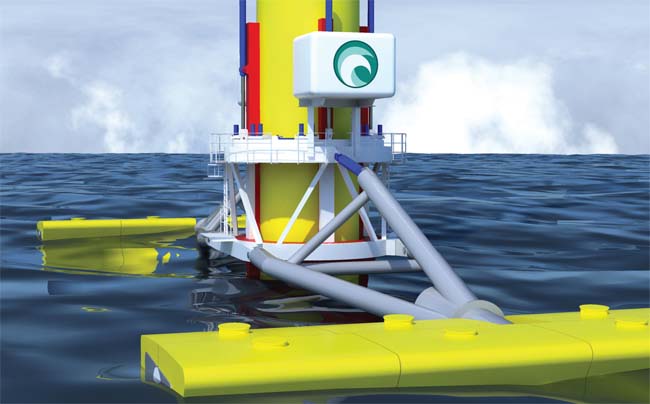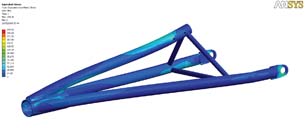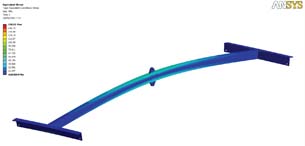Green Ocean Energy Rides the Waves with ANSYS
Simulations that Will Change the World, First Place: Scotland's Green Ocean Energy is poised to perfect its wave-powered energy-generation system using a suite of analysis and modeling software.
Latest News
December 1, 2009
By David Essex
It is ironic that the north of Scotland, a center of the oil & gas industry thanks to its proximity to North Sea oil fields, is an important front in the worldwide movement to replace fossil fuels with renewable energy. But the region’s already vibrant engineering community is not only riding the new wave of innovation to new opportunities, it is making them possible.
 The Wave Treader, developed by Green Ocean Energy and optimized using ANSYS software, mounts on the base of an offshore structure such as a wind turbine or tidal turbine. It produces 500kW of electricity from onboard generators powered by wave action that raises and lowers floating arms, which sit atop buoyant sponsons. |
Green Ocean Energy in Aberdeen might be the best example. The company is a spinoff of the oil & gas engineering firm Nordeng and its use of simulation technologies to develop machines that will ride the ocean to generate electricity earned it the first-place winner in the simulation category of Desktop Engineering’s Change the World Challenge.
“It’s a truly innovative sector,” says Carl Rudd, the Aberdeen-based regional sales manager for ANSYS, the Pittsburgh, PA-based company whose simulation and design tools formed the development platform. “These guys are pushing the boundaries of engineering.”
The challenge was to design a device that was affordable enough to manufacture but could last 25 years, says George Smith, the company’s managing director. Smith, a Nordeng director since its inception in 1987, says he was pondering the possibilities of wave energy when he came up with the concept of Ocean Treader, a freestanding device with parts that move up and down with the waves, using the motion to turn a generator.
 This is an ANSYS simulation of the stress distribution in the Ocean Treader arm. |
The company instead turned its focus to Wave Treader, a smaller, more economical version that can be attached to rigid structures. Though it has roughly half the output of Ocean Treader and is less tolerant of rough waves, it should be easier to commercialize, according to Smith. Besides, Ocean Treader presents an additional design challenge: how to attach its power cable to the floating parts.
Wave Treader consists of sponsons at its front and aft ends, and a spar buoy (a type of tall, thin, upright buoy) in the center. As a wave passes, the forward sponson lifts and falls, then the buoy lifts and falls slightly less, and finally the aft sponson lifts and falls. The relative motion between the three is harvested by cylinders that pressurize hydraulic fluid, which, after smoothing by accumulators, spins hydraulic motors and electric generators. “We use a hydraulic system to effectively smooth out the energy,” Smith says.
Suite Science
Smith focused on structural analysis, using ANSYS DesignSpace and GRAITEC’s SuperStress. Others on the four-person team tackled analysis in ANSYS AQWA and The MathWorks’ MATLAB. “ANSYS allows us to make sure that everything is designed to the correct level,” Smith says. “If something is over-designed, it means it will be too heavy and too expensive. If it is under-designed, it will fail.”
 Figure 3: This is an ANSYS deformation simulation of a spreader beam structure that lifts the Ocean Treader machine safely into the water. |
Rudd says ANSYS Workbench is the foundation on which the other tools rest. Third-party integration played a role. The ANSYS tools can read data from MATLAB, and a single-port ANSYS integration in the 3D modeling and digital prototyping tool, Autodesk Inventor, was expanded to multiple ports. ANSYS trained and worked closely with the team, helping to design and test several scale models. “We took on an initial study for them to look at their design in AQWA,” Rudd says, by importing a file of an Ocean Treader design.
Analyst engineer Tamas Bodai says he had to learn hydrodynamics before using AQWA, which he essentially controls from MATLAB. The team used AQWA to build a model based on the components’ geometry, density, and inertia. They entered wave data to calculate hydrodynamic parameters, such as hydrostatic stiffness and buoyancy, as well as fluid dynamics forces such as diffraction, a measure of a floating body’s effect on waves. The parameters were then fed into code that calculates the kinematic response and power output.
Bodai says he spent much of his time determining how wave movements across the sponsons and buoy could be most beneficially captured, which often became a function of sponson length. “If you want to do it precisely, it takes a very long time,” Bodai says. “One thing is to make sure that the experiment is what you intend to do so you don’t misinterpret the data. You have to make sure it’s detailed enough and complex enough to capture a certain phenomenon.”
The team has used a 1:12.5 scale model to verify AQWA’s calculations, and the software has performed well, according to Smith. “We’ve got quite a high level of confidence,” he says.
Some load and resistance analysis was handled by engineering consultancy Prospect, who also reviewed designs. It focused especially on the impact of Wave Treader on the operational life and reliability of the support structures of offshore wind turbines, a contribution Smith calls pivotal. Prospect used data from a wind farm to determine if a Wave Treader could be added without modifying a turbine’s foundation or upgrading the power cable. The issue is crucial to Wave Treader’s viability. Prospect’s analysis showed it would add 500 kilowatts of output at no additional cost—one-third the output of a turbine, but at constant rates.
“Wave-loading analysis to the level of complexity needed for the design of wave energy abstraction devices is notoriously difficult,” says principal engineer Kevan Stokes. Prospect’s work led to a better understanding of phase shift between the parts of Wave Treaders and to improvements in access for people who will build and maintain them at sea—coincidentally an advance in wind turbine technology, he says. Smith explains that the current approach requires technicians literally to jump from boats onto towers. Now, they will be able to jump more safely onto a Wave Treader sponson that, like the boat, is moving at the same rate as the waves.
Another technical partner, Cadherent, imported Green Ocean Energy’s design models into Autodesk 3ds Max to develop photorealistic animations of device movement, which was helpful in designing access platforms and explaining the setup to potential investors. “The most challenging aspect for us was to accurately simulate the buoyancy of the Wave Treader and the Ocean Treader,” says Cadherent Managing Director David Thomson. “I understand that interfacing with a conical wind turbine column was a challenge for Green Ocean, which would have proved much harder if it were not for modern CAD programs.”
Just Over the Horizon
Smith says the company is raising money and finalizing designs to build a full-size prototype next year. “We’re looking at the electrical and hydraulic system design,” he says. “We’re looking at the sustainability of the machine,” including simulating the load during storms. “It’s really about surviving huge waves.” Smith says waves average 2-3 meters at the prototype’s likely location, but can reach 7-8 meters. “We have to be sure that for any given site, we design for the worst possible scenario,” he says. Then the company will turn its attention to manufacturing issues, with hopes of commercialization in 2011. “We’re like the Model T: we’re very early on in this industry.”
The design is attracting notice from numerous quarters, including the Scottish government, which gave it a SMART award for technically challenging innovation. “Wave Treader is immensely popular, it seems,” Smith says. “We have had tremendous interest from operators of offshore wind farms.” The growth potential seems huge, and the oil & gas industry, with its rigs and platforms, is another potential target. “Any offshore structure which is rigid, we could probably attach a Wave Treader to,” Smith says, adding that the devices could also have their own platforms. The British government estimates that marine energy could fill five percent of Europe’s energy needs, he says.
Desktop engineering will play a big role in this energy future, Stokes says. “Wind turbine power output, for example, used to be considered unreliable because it was unpredictable, but there are now ever-improving software programs that are very good at predicting this,” he says. “We will have reliable, cost-effective, renewable energy production systems that are several orders of magnitude kinder to the environment than those that we use at present, and this will only be possible as a consequence of the computer-based design and engineering software that we have.”
Rudd says the stakes are high for ANSYS users like Green Ocean Energy. “They have to get these products right, because financial constraints don’t allow them to build a full-scale prototype,” Rudd says. “When the full-scale model—which really is the product, basically—goes into the sea, it’s got to work the first time. Think of the cost if that thing falls to the bottom.”
More Info:
ANSYS
Freelance writer David Essex has covered IT for 23 years. He was a BYTE editor and has written for Computerworld, PC World, among other publications. Send e-mail about this article to [email protected].
Subscribe to our FREE magazine, FREE email newsletters or both!
Latest News
About the Author
DE’s editors contribute news and new product announcements to Digital Engineering.
Press releases may be sent to them via [email protected].






